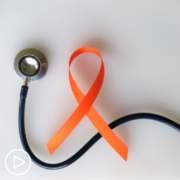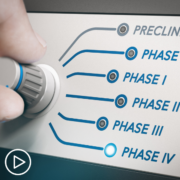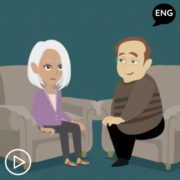CLL Treatment Approaches: What Are the Types?
CLL Treatment Approaches: What Are the Types? from Patient Empowerment Network on Vimeo.
What treatment options are there for CLL patients? Dr. Catherine Coombs explains the types of CLL approaches available and who they may be appropriate for.
Dr. Catherine Coombs is an Assistant Professor of Medicine in the Division of Hematology at The UNC Lineberger Comprehensive Cancer Center. Learn more about Dr. Coombs here.
Related Resources:

|

|

|
Transcript:
Katherine:
Let’s walk through the types of treatments that are used today to treat CLL.
Dr. Coombs:
So, for the non-watch-and-wait category, that means we are now thinking about therapy. Most of the time that involves a targeted agent.
We largely are using a lot less in the way of cytotoxic chemotherapy. Not to say there isn’t a role for it, but in my own practice, it’s not something that I have been using in the past several years because it’s highly toxic. It is effective, but it can lead to some long-term toxicities. And it’s also not quite as effective as these new targeted agents. So, those fall into two major classes.
The first class is a class of drugs called BTK inhibitors. That stands for Bruton’s tyrosine kinase. That’s an important target in the CLL cells, specifically. The CLL cells are a type of B cell. So, BTK is important for the signaling of both normal and cancerous B cells. When we use drugs to block that protein, that impairs the CLL cells’ ability to multiply. Then we ultimately are able to control the disease with prolonged administration of one of these drugs.
There are two FDA-approved BTK inhibitors. The first FDA-approved agent is a drug called ibrutinib (Imbruvica). And then the newer agent is called acalabrutinib (Calquence). There’s another drug that you may have heard of called zanubrutinib (Brukinsa). That is not technically yet FDA-approved for CLL, but it is occasionally used given that it is FDA-approved for other lymphomas, and it is within the national cancer center network guidelines for CLL treatment.
The big benefit of these drugs is they work phenomenally well at controlling the CLL. I would say the major downside is that they do have to be taken indefinitely. So, patients ask, “Am I going to be on it forever?” Well, it depends on what you mean by forever. We generally keep patients on these drugs as long as number one, they’re tolerating them, so no bad side effects, and then number two, as long as the CLL is staying under control.
So, for that 85-year-old patient that I gave as an example, forever may be until the rest of their life. Because they can work for six, seven, eight plus years; so, they’re highly effective. Some patients may go on them and then die from something else years down the road. For the younger patients, or patients who progress faster, we would then put them on something else whenever the drug stopped working, provided that they didn’t have a significant side effect to the drug class. So, that’s a big first class.
The second large subset of therapies is a drug called venetoclax (Venclexta), which we typically combine with an anti-CD20 drug. The one that we use for patients who are getting their first treatment is called obinutuzumab (Gazyva). Venetoclax is a BCL-2 inhibitor that inhibits this pathway within CLL cells. It’s not unique to CLL cells, but the CLL cells are particularly dependent upon it called apoptosis.
So, when they get exposed to this drug, the CLL cells just die; they can’t continue living, they die off. So, venetoclax works really exquisitely well at killing off CLL cells. Probably works better when it’s paired with this drug obinutuzumab. That’s how it was approved in the frontline setting: those two drugs together. The big risk of that therapy, essentially, it’s kind of a weird risk, when the CLL cells die too quickly that can cause some problems in the human body because one has to metabolize all the debris left over from these dead cancer cells. The medical term we use for that is tumor lysis syndrome.
That can actually be fatal if not done in a safe way. Fortunately, when we do it as per the recommendations by the manufacturer, we’ve not had any adverse severe problems from it. It ends up being that the patient has to come in weekly every five weeks to do a slow ramp-up of the drug to kind of slowly kill off the cancer cells so that the body isn’t overwhelmed by the contents of these dead cancer cells.
The big advantage of this regimen is that because it kills the CLL so well, people can get into very deep remissions. So, instead of being a therapy that people are on indefinitely, it’s designed as a one-year therapy when given as the first therapy. So, it’s one year and then they’re done. People after that are in remission, they’re not on any treatment. They may feel like they don’t have CLL.
Most of the time the CLL does come back. It depends on does the patient come back for something else? Which does happen when people are older. But it appears that it keeps people in remission for several years. The median, which is how long it takes for half of patients to have their disease come back, the median progression for survival has not yet been reached for the trial that was done using this therapy.
So, that’s at least three, four plus years that we’ve been able to follow people. So, very attractive in that you’re done, and then you just wait for the disease to come back but largely feel good in the interim.










